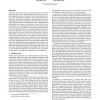Free Online Productivity Tools
i2Speak
i2Symbol
i2OCR
iTex2Img
iWeb2Print
iWeb2Shot
i2Type
iPdf2Split
iPdf2Merge
i2Bopomofo
i2Arabic
i2Style
i2Image
i2PDF
iLatex2Rtf
Sci2ools
APVIS
2009
2009
Visualizing time-varying features with TAC-based distance fields
To analyze time-varying data sets, tracking features over time is often necessary to better understand the dynamic nature of the underlying physical process. Tracking 3D time-varying features, however, is non-trivial when the boundary of the features cannot be easily defined. In this paper, we propose a new framework to visualize time-varying features and their motion without explicit feature segmentation and tracking. In our framework, a time-varying feature is described by a time series or Time Activity Curve (TAC). To compute the distance, or similarity, between a voxel's time series and the feature, we use the Dynamic Time Warping (DTW) distance metric. The purpose of DTW is to compare the shape similarity between two time series with an optimal warping of time so that the phase shift of the feature in time can be accounted for. After applying DTW to compare each voxel's time series with the feature, a time-invariant distance field can be computed. The amount of time war...
| Added | 08 Nov 2010 |
| Updated | 08 Nov 2010 |
| Type | Conference |
| Year | 2009 |
| Where | APVIS |
| Authors | Teng-Yok Lee, Han-Wei Shen |
Comments (0)

